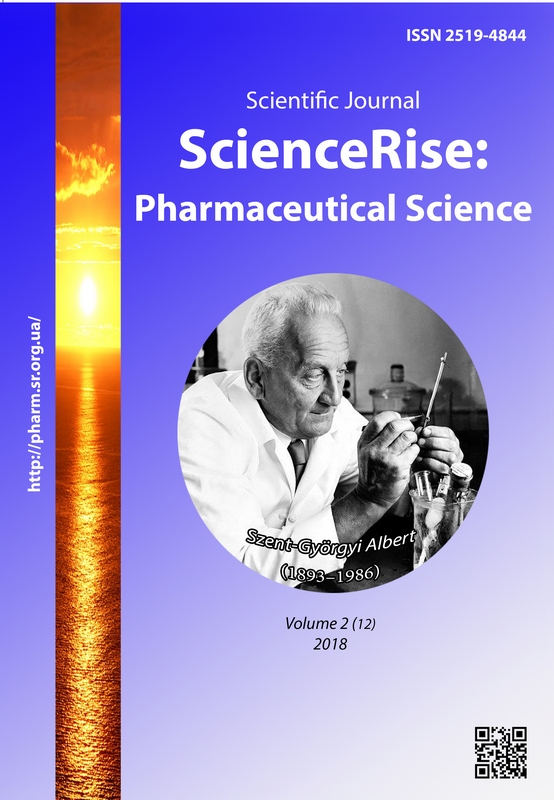Methodological approaches to the search of new herbal anticonvulsants
DOI:
https://doi.org/10.15587/2519-4852.2018.129599Keywords:
antiepileptic activity, herbs, herbal substances, algorithm, PASS tool, index of activityAbstract
Aim. Development of the most appropriate algorithm for the search and selection of herbs showing anticonvulsant properties, as well as to interpret the level of anticonvulsant activity of different groups of herbal substances using PASS tool.
Methods. Literature analysis and PASS software were used for development of a clear algorithm for finding the most suitable herbs having anticonvulsant activity.
Results. The most rational decision in case of development of the algorithms for the targeted search of herbs for epilepsy treatment is to divide herbal objects according to their chemical composition and mechanism of action. It was found that certain groups of biologically active compounds (alkaloids, flavonoids, phenolic acids) and some members of the Betulaceae, Papaveraceae, Solanaceae, Fumariaceae, Lamiaceae, Polemoniaceae, Viscaceae, and Oleaceae families have anticonvulsant activity. PASS analysis resulted that antiepileptic activity is inherent, but not significant for most of the studied compounds. Particular expectations caused the analysis of the results of alkaloids protopine and sanguinarine due to their high indexes of activity – 0.813 and 0.820 %, respectively.
Conclusion. The algorithm for selection of the most promising herbs for the further detailed phytochemical and pharmacological studies concerning possibilities of their use for treatment of epilepsy was substantiated. PASS prediction analysis for different groups of herbal substances was carried out. As expected, according to the PASS prediction results, antiepileptic activity is inherent, but not significant for most of the studied compounds. The analyzed compounds have the likelihood of manifestation of antiepileptic activity: the indexes of activity of the analyzed substances are in range from 0.430 to 0.754 %. Several biologically active compounds may have neuroprotector activity; the highest indexes were obtained for histidine (0.680 %) and alanine (0.718 %). Amino acids asparagine and serine have shown probable presence of cognition activator activity (0.489 % and 0.554 %, respectively)
References
- Kumar, S., Madaan, R., Bansal, G., Jamwal, A., Sharma, A. (2012). Plants and Plant Products with Potential Anticonvulsant Activity – A Review. Pharmacognosy Communications, 2 (1), 3–99. doi: 10.5530/pc.2012.suppl1.2
- Nsour, W. M., Lau, C. B.-S., Wong, I. C. K. (2000). Review on phytotherapy in epilepsy. Seizure, 9 (2), 96–107. doi: 10.1053/seiz.1999.0378
- Tsyvunin, V., Shtrygol, S., Prokopenko, Y., Georgiyants, V., Blyznyuk, N. (2016). Influence of dry herbal extracts on pentylenetetrazole-induced seizures in mice: screening results and relationship “chemical composition – pharmacological effect.” ScienceRise: Pharmaceutical Science, 1 (1), 18–28. doi: 10.15587/2519-4852.2016.71518
- Krovat, E., Steindl, T., Langer, T. (2005). Recent Advances in Docking and Scoring. Current Computer Aided-Drug Design, 1 (1), 93–102. doi: 10.2174/1573409052952314
- Anzali, S., Barnickel, G., Cezanne, B., Krug, M., Filimonov, D., Poroikov, V. (2001). Discriminating between Drugs and Nondrugs by Prediction of Activity Spectra for Substances (PASS). Journal of Medicinal Chemistry, 44 (15), 2432–2437. doi: 10.1021/jm0010670
- Mathews, G. C. (2007). The Dual Roles of GABA in Seizures and Epilepsy Generate More Excitement. Epilepsy Currents, 7 (1), 28–30. doi: 10.1111/j.1535-7511.2007.00159.x
- Prokopenko, Y., Tsyvunin, V., Shtrygol, S., Georgiyants, V. (2015). In Vivo Anticonvulsant Activity of Extracts and Protopine from the Fumaria schleicheri Herb. Scientia Pharmaceutica, 84 (3), 547–554. doi: 10.3390/scipharm84030547
- Mojaradl, T. B., Roghani, M. (2014). The anticonvulsant and antioxidant effects of berberine in kainate-induced temporal lobe epilepsy in rats. Basic and clinical neuroscience, 5 (2), 124–130.
- Chauhan, K., Sheth, N., Ranpariya, V., Parmar, S. (2010). Anticonvulsant activity of solasodine isolated fromSolanum sisymbriifoliumfruits in rodents. Pharmaceutical Biology, 49 (2), 194–199. doi: 10.3109/13880209.2010.508499
- Zhu, H.-L., Wan, J.-B., Wang, Y.-T., Li, B.-C., Xiang, C., He, J., Li, P. (2013). Medicinal compounds with antiepileptic/anticonvulsant activities. Epilepsia, 55 (1), 3–16. doi: 10.1111/epi.12463
- Johnston, G. A. R., Chebib, M., Duke, R. K., Fernandez, S. P., Hanrahan, J. R., Hinton, T., Mewett, K. N. (2009). Herbal Products and GABA Receptors. Encyclopedia of Neuroscience, 1095–1101. doi: 10.1016/b978-008045046-9.00868-8
- Xu, L.-F., Chu, W.-J., Qing, X.-Y., Li, S., Wang, X.-S., Qing, G.-W. et. al. (2006). Protopine inhibits serotonin transporter and noradrenaline transporter and has the antidepressant-like effect in mice models. Neuropharmacology, 50 (8), 934–940. doi: 10.1016/j.neuropharm.2006.01.003
- Wasowski, C., Marder, M. (2012). Flavonoids as GABA receptor ligands: the whole story? Journal of experimental pharmacology, 4, 9–24. doi: 10.2147/jep.s23105
- Carpentier, P., Foquin, A., Rondouin, G., Lerner-Natoli, M., de Groot, D. M., Lallement, G. (2000). Effects of atropine sulphate on seizure activity and brain damage produced by soman in guinea-pigs: ECoG correlates of neuropathology. Neurotoxicology, 21 (4), 521–540.
- Grigoletto, J., Oliveira, C. V. de, Grauncke, A. C. B., Souza, T. L. de, Souto, N. S., Freitas, M. L. de et. al. (2016). Rosmarinic acid is anticonvulsant against seizures induced by pentylenetetrazol and pilocarpine in mice. Epilepsy & Behavior, 62, 27–34. doi: 10.1016/j.yebeh.2016.06.037
Downloads
Published
How to Cite
Issue
Section
License
Copyright (c) 2018 Yuliya Prokopenko, Victoriya Georgiyants

This work is licensed under a Creative Commons Attribution 4.0 International License.
Our journal abides by the Creative Commons CC BY copyright rights and permissions for open access journals.








